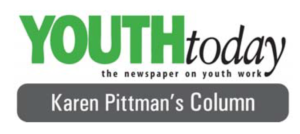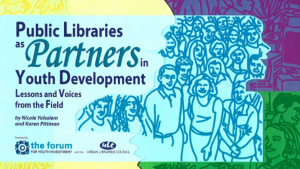“Kids need places to go, people to talk to and possibilities to explore.”

In the midst of escalating alarm about youth problems and youth unrest, any youth services program that could fill its report card with zeroes — no drugs, no pregnancies, no STDs, no arrests — would be hailed by funders, envied by competitors and hounded by replication specialists. This program will, indeed, have earned recognition. The question is, will we use this attention to hammer home the fact that the “science” of prevention was actually the art of promotion? Prevention may be the headline, but the story is development. Can’t we make the headline reflect the reality of what teens need and want and what youth workers do?
I think we can. We know “what works.” As Richard Murphy, former Commissioner of Youth Services in New York City, put it, “Kids need places to go, people to talk to and possibilities to explore.” The nationally recognized Beacon schools, developed by Murphy, are one of America’s best recent success stories. Based on Murphy’s simple formula, they embody the basic ideas of youth and community development.
These ideas are making their circuitous way through Washington where domestic policy debates are still liberally peppered with the language of dysfunction, detention and deterrence. By contrast, the proposed Youth Development Block Grant, backed by the National Collaboration for Youth, is brimming over with language that salutes the importance of community-based youth organizations that provide guided opportunities for stable relationships, meaningful participation, family involvement, active learning and skill development.
Perhaps more noteworthy is the appearance of youth development language in congressional and administrative efforts to address drug abuse, crime and violence. The Crime Bill’s overall approach to curbing youth violence is clearly problematic. The Ounce of Prevention provision, however, offers up new dollars for programs traditionally associated with youth development — recreation and sports, after-school enrichment, community service, youth leadership. A recent HHS RFP on gang prevention states that “first and foremost, strategies have to be grounded within a youth development framework rather than the usual problem-oriented approach.”
Youth development strategies are at last taken seriously in prevention discussions. A beginning, but not enough. Prevention is not the ultimate goal. More important, it may not be a completely achievable goal. Only the proposed Block Grant dares to say that while problem prevention is a possible outcome, the primary function of youth development programs is to “make a major contribution to helping youth develop the life skills and moral values” needed to face “the challenges of adolescence” and the “responsibilities of adulthood.” Prevention, described here, is a by-product of a commitment to youth development.
Most program directors candidly acknowledge that they are promoting youth development, even though they are using problem-focused, categorical funding. Why then, don’t youth workers unabashedly tell the public what they are doing? Why label programs using prevention language and evaluate only in dubious prevention terms? Common answers: That’s how the money flows. That’s how the public and politicians think. Why switch labels? It doesn’t make any difference.
From my viewpoint, it makes a huge difference. This isn’t just about semantics. This is about letting people know that we don’t just prevent. We promote. Let’s start labeling our programs that way and insisting that they be evaluated that way too. Let’s develop outcome measures that will show how youth work enriches the lives of young people, promotes health, community responsibility and economic self-sufficiency. Let’s define our principles of practice. Yes, youth workers fill gaps and respond to crises. But what we do best is promote the development of young people. We’ve got a good product. We know what works. More important, we know why. Let’s give it a truthful label. The rest, as Richard Murphy always reminds me, “is marketing.”
We welcome your contributions to the topic. Please reach out to talkwithus@kpcatalysts.com if you’d like to join to the discussion.
Pittman, K. (1994, July/August). “Truth In Labeling.” Washington, DC: The Forum for Youth Investment. A version of this article appears in Youth Today. July 1, 1994




No comment yet, add your voice below!